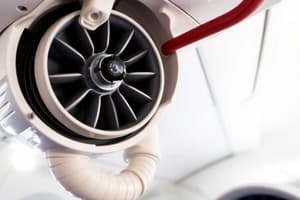Podcast
Questions and Answers
Which of the following file extensions is commonly associated with a Portable Document Format?
Which of the following file extensions is commonly associated with a Portable Document Format?
- .docx
- .pdf (correct)
- .txt
- .xlsx
Which of the following is a function of optical character recognition?
Which of the following is a function of optical character recognition?
- Converting images into editable text (correct)
- Compressing documents for storage
- Encrypting documents for security
- Displaying text in a graphical format
What is the primary purpose of a 'mark sheet' in an academic context?
What is the primary purpose of a 'mark sheet' in an academic context?
- To track library book borrowing history
- To provide general feedback on student behavior
- To display student attendance records only
- To record grades or marks obtained by students in various assessments (correct)
Which of the following is NOT a typical component found within a standard document?
Which of the following is NOT a typical component found within a standard document?
What does the acronym OCR stand for?
What does the acronym OCR stand for?
Flashcards
Amt 223
Amt 223
A course or subject code typically denoting a specific educational class or topic.
Part 1
Part 1
The first section of a larger document or course material.
Course code
Course code
A short alphanumeric code used to identify a specific course in an academic system.
Educational material
Educational material
Signup and view all the flashcards
Section
Section
Signup and view all the flashcards
Study Notes
Introduction
- Aircraft fly at high altitudes primarily for economic reasons, as humans cannot survive in those environments.
- Altitudes of 40,000 feet have temperatures around −56°C.
- Air pressure at high altitudes is low, and there's insufficient oxygen.
- Aircraft crews and passengers must be protected from freezing and the risk of death at such altitudes.
Air Conditioning System
- The system ensures proper cabin pressure for life support.
- The system maintains a comfortable cabin temperature.
- On the ground, air conditioning is vital to prevent overheating of equipment and discomfort for passengers.
Air Conditioning Functions
- The air conditioning system maintains fresh, clean air.
- It maintains a comfortable temperature.
- It maintains the correct humidity level.
- It supplies correct cabin pressure.
Pressurization and Zones
- Some aircraft parts (e.g., passenger compartment, cockpit) are pressurized, while others (e.g., landing gear bays, tail cone) are not.
- Pressurization is regulated to accommodate the change in altitude.
- Pressurization differs according to zone (e.g., cockpit, passenger compartment, cargo) because each zone has different operational needs and temperatures.
- The B747-400 has 7 zones.
- The A320 has 3 zones.
System Layout
- Air conditioning systems obtain air from the pneumatic system.
- Air conditioning systems start operation at pack valves.
- Systems mix cooled air with hot air, to reach the desired temperatures.
- Pressurization levels are regulated by outflow valves.
- Air is cooled by multiple identical packs.
- The system is regulated by outflow valves to regulate the pressure.
Temperature
- The cockpit temperature is usually lower than other cabin areas.
- Air temperature in the passenger compartment and other areas is regulated according to need.
- Electrical and electronic devices create heat.
- Air temperature demands for some zones (e.g. upper deck, main deck) have specific requirements, for example: upper deck: 24°C; and main deck: 20°C
Studying That Suits You
Use AI to generate personalized quizzes and flashcards to suit your learning preferences.



